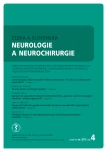A Coagulopathy Following Craniocerebral Injury in Children and Adolescents
Authors:
M. Benčo 1; J. De Riggo 1; S. Nosáľ 2; M. Fedor 2; J. Šutovský 1; R. Opšenák 1
Authors‘ workplace:
UN Martin
Neurochirurgické oddelenie
1; UN Martin
Klinika detskej anestéziológie a intenzívnej medicíny JLF UK v Martine
2
Published in:
Cesk Slov Neurol N 2012; 75/108(4): 432-437
Category:
Original Paper
Overview
Aim:
To examine a relationship between coagulation parameters (prothrombin time, international normalized ratio, activated partial thromboplastin time, thrombin time and platelet count) and outcome in children after isolated craniocerebral injury.
Methods:
A retrospective study included 51 children (33 males and 18 females) aged 1–17 years, who undergone a surgery between 1. 1. 2005 and 1. 3. 2011. Coagulation parameters, examined within 6 hours after the injury, were compared for different types of craniocerebral injury and correlated with neurological status after injury and after treatment.
Results:
Coagulation parameters correlated with neurological status after injury and after treatment and differed significantly for different types of craniocerebral injury (except platelet count).
Conclusion:
A coagulation disorder occurring after an isolated craniocerebral injury in children is a negative prognostic factor that requires an urgent and aggressive therapy.
Key words:
craniocerebral injury – coagulopathy – prognosis
Sources
1. Stein SC, Spettell CM. Delayed and progressive brain injury in children and adolescents with head trauma. Pediatr Neurosurg 1995; 23(6): 299–304.
2. Bruce DA. Head trauma. In: Eichelberger MR (ed). Pediatric Trauma. St. Louis: Mosby Year Book 1993 : 353–361.
3. Kirsch TD, Lipinski AC. Head injury. In: Tintinalli JE (ed). Emergency medicine: A comprehensive study guide. 6th ed. New York: McGraw-Hill 2004 : 1557–1569.
4. Valadka AB. Injury to the cranium. In: Mattox KL, Feliciano DV, Moore EE (eds). Trauma. 4th ed. New York: McGraw-Hill 2000 : 377–399.
5. Smrčka M. Monitoring pacientů s těžkým poraněním mozku. Cesk Slov Neurol N 2011; 74/107(1): 9–21.
6. Zapletalová J, Aleksijević D, Smolka V, Krahulík D, Fryšák Z. Posttraumatický hypopituitarizmus u dětí a dospívajících. Cesk Slov Neurol N 2010; 73/106(4): 398–401.
7. Aleksijević D, Zapletalová J, Smolka V, Klásková E, Wiedermann J, Krahulík D et al. Neuroendokrinní dysfunkce u dětí a dospívajících po úrazu mozku. Cesk Slov Neurol N 2010; 73/106(4): 409–414.
8. Bayir A, Kalkan E, Koçak S, Ak A, Cander B, Bodur S. Fibrinolytic markers and neurologic outcome in traumatic brain injury. Neurol India 2006; 54(4): 363–365.
9. Bauer J. Antikoagulační terapie v prevenci a léčbě ischemických iktů. Cesk Slov Neurol N 2010;73/106(5): 480–491.
10. Engström M, Romner B, Schalén W, Reinstrup B. Thrombocytopenia predicts progressive hemorrhage after head trauma. J Neurotrauma 2005; 22(2): 291–296.
11. Stein SC, Young GS, Talucci RC, Greenbaum BH, Ross SE. Delayed brain injury after head trauma: significance of coagulopathy. Neurosurgery 1992; 30(2): 160–165.
12. Cohen J. Statistical power analysis for the behavioral sciences. 2nd ed. Hillsdale: Lawrance Earlbaum Associates 1998.
13. Vavilala MS, Dunbar PJ, Rivara FP, Lam AM. Coagulopathy predicts poor outcome following head injury in children less than 16 years of age. J Neurosurg Anesthesiol 2001; 13(1): 13–18.
14. String T, Robinson AJ, Blaisdell FW. Massive trauma: effect of intravascular coagulation on prognosis. Arch Surg 1971; 102(4): 406–411.
15. Dutton RP. Factor VII and the brain: time to get this research done! Crit Care 2007; 11(4): 161.
16. Stein DM, Dutton RP, Kramer ME, Scalea TM. Reversal of coagulopathy in critically ill patients with traumatic brain injury: recombinant factor VIIa is more cost--effective than plasma. J Trauma 2009; 66(1): 63–72.
17. Jennett B, Teasdale G, Braakman R, Minderhoud J, Knill-Jones R. Predicting outcome in individual patients after severe head injury. Lancet 1976; 1(7968): 1031–1034.
Labels
Paediatric neurology Neurosurgery NeurologyArticle was published in
Czech and Slovak Neurology and Neurosurgery

2012 Issue 4
- Advances in the Treatment of Myasthenia Gravis on the Horizon
- Metamizole at a Glance and in Practice – Effective Non-Opioid Analgesic for All Ages
- Memantine in Dementia Therapy – Current Findings and Possible Future Applications
Most read in this issue
- Cerebral Arachnoid Cysts in Adults – Retrospective Analysis of the Results of Surgical Treatment
- Rhythmic Movement Disorder
- Isolated Sphenoid Sinusitis – Possible Cause of Headache and Severe Complications
- The Oswestry Questionnaire, Version 2.1a – Results in Patients with Lumbar Spinal Stenosis, Comparison with the Previous Version of the Questionnaire
